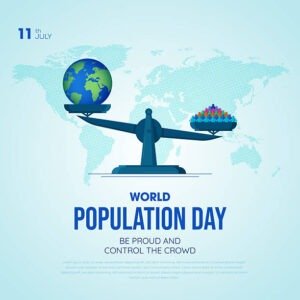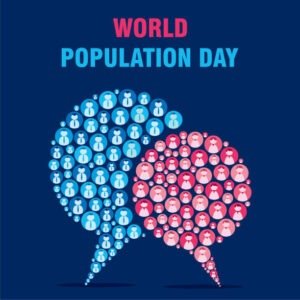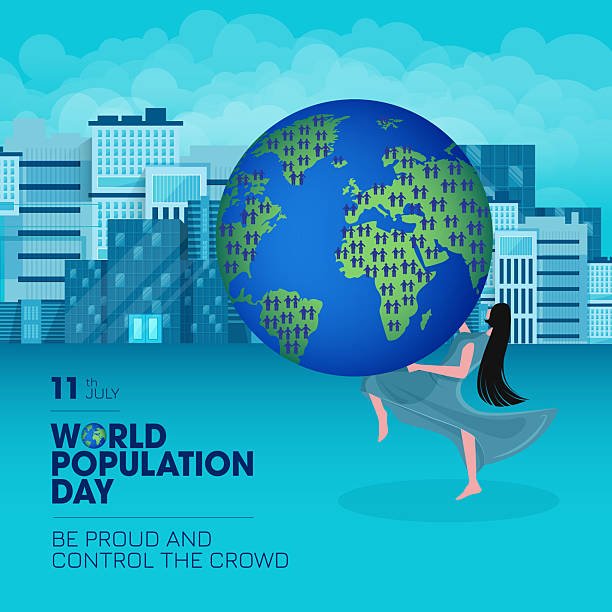World Population Day: Every year, World Population Day is observed on July 11 to raise awareness about global population issues. From resource scarcity to climate change, overpopulation has far-reaching consequences that impact every corner of our planet. This observance highlights the pressing need for sustainable development, access to reproductive healthcare, and gender equality.

In this blog, we will explore the history, importance, and objectives of World Population Day, along with this year’s theme and how countries worldwide are addressing population-related challenges.
The History of World Population Day:
The origin of World Population Day dates back to 1989, following an idea proposed by Dr. K.C. Zachariah, a senior demographer working at the World Bank. The inspiration came after the world population reached five billion on July 11, 1987, a milestone that was both significant and alarming. It made global leaders think deeply about the implications of population growth.
Recognizing the need to highlight these issues on a global platform, the Governing Council of the United Nations Development Programme (UNDP) established World Population Day in 1989. Since then, it has been observed every year on July 11, engaging governments, NGOs, and citizens to address population concerns.
Why World Population Day Matters:
World Population Day is more than just an awareness campaign; it’s a crucial reminder of the challenges and responsibilities we face as a global community. Here’s why this day is important:
1. Population Explosion
The world population has grown from 1 billion in 1800 to over 8 billion in 2022. This rapid growth puts tremendous pressure on natural resources, healthcare, education, and employment.
2. Reproductive Health Rights
Millions of women around the world still lack access to safe contraception, maternal healthcare, and family planning services. World Population Day promotes reproductive rights for all.
3. Sustainable Development
A rapidly growing population makes it difficult to achieve the United Nations Sustainable Development Goals (SDGs), especially those related to poverty, hunger, education, and gender equality.
4. Climate Change
More people mean higher carbon emissions, deforestation, and pollution. Addressing population issues is essential to tackling the climate crisis.
World Population Growth: Key Statistics
To understand the magnitude of the challenge, let’s look at some global population statistics:
-
1800 – World population: 1 billion
-
1927 – World population: 2 billion
-
1960 – World population: 3 billion
-
1974 – World population: 4 billion
-
1987 – World population: 5 billion (trigger for World Population Day)
-
1999 – World population: 6 billion
-
2011 – World population: 7 billion
-
2022 – World population: 8 billion
-
Projected 2050 – Over 9.7 billion
Asia remains the most populous continent, with China and India together accounting for more than 36% of the world’s population.
World Population Day Themes Over the Years:
Each year, the United Nations assigns a specific theme to World Population Day to focus attention on particular aspects of population issues. Here are some of the recent themes:
-
2023: Unleashing the power of gender equality: Uplifting the voices of women and girls
-
2022: A world of 8 billion: Towards a resilient future for all — Harnessing opportunities and ensuring rights and choices for all
-
2021: Rights and Choices are the Answer: Whether baby boom or bust, the solution to shifting fertility rates lies in prioritizing reproductive health and rights
-
2020: Putting the brakes on COVID-19: How to safeguard the health and rights of women and girls now
These themes reflect global concerns ranging from fertility rates and gender rights to pandemic recovery and sustainable development.

How World Population Day Is Observed:
World Population Day is marked by various events across the globe:
✔️ Awareness Campaigns
Governments and NGOs run educational campaigns to inform the public about the consequences of overpopulation and the importance of family planning.
✔️ Community Outreach
Health departments organize free health check-ups, family planning counseling, and distribution of contraceptives, especially in rural and underserved areas.
✔️ Media and Online Events
Talk shows, social media drives, webinars, and blog articles are released to reach global audiences and highlight personal stories and expert insights.
✔️ Policy Advocacy
Policy discussions focus on reproductive health laws, population control strategies, and climate action linked to population dynamics.
World Population Day 2024: What to Expect?
As we approach World Population Day 2024, the focus is expected to remain on empowering women, investing in reproductive health services, and addressing the demographic shift seen in many countries, especially with aging populations and declining birth rates in developed regions, versus population booms in developing nations.
Challenges the World Still Faces:
Even after decades of awareness, many challenges persist:
-
Lack of family planning in rural areas
-
Teen pregnancies and child marriages
-
Overcrowding in urban centers
-
Gender inequality in education and healthcare
-
Environmental degradation due to population pressure
These issues underline the importance of education, government policy, and global cooperation to manage population growth.
What Can You Do?
As an individual, you can contribute to the goals of World Population Day by:
-
Educating Yourself and Others – Share facts and resources about population issues.
-
Supporting Women’s Rights – Advocate for gender equality and access to healthcare.
-
Volunteering with NGOs – Get involved in organizations working on population health and education.
-
Promoting Sustainable Living – Adopt eco-friendly habits that reduce your resource footprint.
World Population Day is not just about numbers — it’s about people. It’s about ensuring that every individual has the right to live with dignity, access to health services, and opportunities to thrive. As our global population continues to grow, so must our awareness, compassion, and commitment to sustainable and equitable solutions.
Whether you’re a student, policymaker, activist, or global citizen, this day invites you to think critically, act responsibly, and help shape a better world for the generations to come.
ऐसे और भी एक्सप्लेनर लेखों के लिए हमारे साथ जुड़े रहें! Khabari bandhu पर पढ़ें देश-दुनिया की ताज़ा ख़बरें — बिज़नेस, एजुकेशन, मनोरंजन, धर्म, क्रिकेट, राशिफल और भी बहुत कुछ।
Elon Musk Launches New Political Party: Vision, Goals, and Impact

